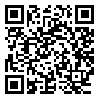university , barghamadi@uma.ac.ir
Abstract: (3835 Views)
Volleyball players are looking to apply their force at a short time speed to transfer more diagonal and vertical blows on the ball so that you land on the opposing team's field more quickly and make it difficult for the opposing team players to receive. It seems that various types of resistance training can improwe the vertical force of the spike skill.
Therefore the aim of the current study is to compare the effects of two types of resistance training (exercises with cable machines and exercise with barbells and free weights) on vertical force and impulse caused by diagonal hit on spike skill in college girl volleyball players. The present study method was semi-experimental. The statistical samples in this study included 45 girl volleyball players from university of Mohaghegh Ardabili. In three groups of 15 in groups 1 and 2 strength training intervention for two days a week, in 7 strenght movements with a cable bodybulding machine and barbell, dumbbell, and medicine training tools, observing the principle of overload in three movement intensities: 80%, 5 repetition, 90%, 2 repetition, 100%, one maximum repetition and in the third group in the form of a control group were identified. Strength training as an independent variable and vertical force and impulse as a dependent variable. Bertek force plate was used to record ground reaction forces. The table was used to adjust height, the invisible thread and the ball for the dominant hand shot in the volleyball players. In this study, ANOVA test was used with a significance level of 0.05. The effects of the force resulting from the diagonal impact on the ball in line with the vertical force of the ground reaction were significant in intervention group 1 (p< 0.008) and intervention group 2 was not significant (p< 0.133).The effect of the impulse time factor in the strength training group was significant in the vertical component of the ground reaction in intervention group1 (P<0.030) and in intervention group 2 (P<0.023). The difference between the groups in the intervention group shows the effect of the vertical force factor in the intervention group 1 with the impact factor (v = 0.016) compared to the group 2 also, in the impulse factor, impact factor was effective in intervention group1 (v = 0.190) and strength training in intervention group 2 (v = 0.167). It seems that barbell and medicine ball strength exercises increased force in diagonal strikes and produce the maximum vertical force in the shorter time to the ball in the spike skill of the diagonal strike of the volleyball players.
Therefore the aim of the current study is to compare the effects of two types of resistance training (exercises with cable machines and exercise with barbells and free weights) on vertical force and impulse caused by diagonal hit on spike skill in college girl volleyball players. The present study method was semi-experimental. The statistical samples in this study included 45 girl volleyball players from university of Mohaghegh Ardabili. In three groups of 15 in groups 1 and 2 strength training intervention for two days a week, in 7 strenght movements with a cable bodybulding machine and barbell, dumbbell, and medicine training tools, observing the principle of overload in three movement intensities: 80%, 5 repetition, 90%, 2 repetition, 100%, one maximum repetition and in the third group in the form of a control group were identified. Strength training as an independent variable and vertical force and impulse as a dependent variable. Bertek force plate was used to record ground reaction forces. The table was used to adjust height, the invisible thread and the ball for the dominant hand shot in the volleyball players. In this study, ANOVA test was used with a significance level of 0.05. The effects of the force resulting from the diagonal impact on the ball in line with the vertical force of the ground reaction were significant in intervention group 1 (p< 0.008) and intervention group 2 was not significant (p< 0.133).The effect of the impulse time factor in the strength training group was significant in the vertical component of the ground reaction in intervention group1 (P<0.030) and in intervention group 2 (P<0.023). The difference between the groups in the intervention group shows the effect of the vertical force factor in the intervention group 1 with the impact factor (v = 0.016) compared to the group 2 also, in the impulse factor, impact factor was effective in intervention group1 (v = 0.190) and strength training in intervention group 2 (v = 0.167). It seems that barbell and medicine ball strength exercises increased force in diagonal strikes and produce the maximum vertical force in the shorter time to the ball in the spike skill of the diagonal strike of the volleyball players.
Send email to the article author
| Rights and permissions | |
 |
This work is licensed under a Creative Commons Attribution-NonCommercial 4.0 International License. |





